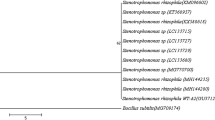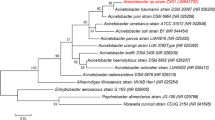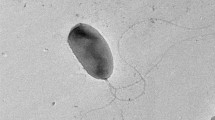Abstract
The p-hydroxybenzoic acid (HBA) released by the plant itself has becoming the main autotoxin for tea ratoon continuous cropping, which had influenced the recycling land/natural resources and economic benefits of the crop. In this study, continuous cropping of Wuyi rock tea at the same area for 32 years’ soil was collected to obtain an effective HBA degrading strain. Pseudomonas fluorescens strain ZL22 was isolated and subject to morphological identification and phylogenetic analysis. Biodegradation experiments showed that it could tolerate a high (5 g/L) HBA concentration and under optimal conditions degraded it within 7 days. The enzyme optimization of p-hydroxybenzoate hydroxylase was 30°C, pH 6 and maintained at least 90% residual activity enzyme activity within 25 min. This result indicated that ZL22 possessed an HBA degradation pathway and not only rapidly degraded the autotoxic substance, but also helped strain ZL22 to colonize the rhizosphere soil by using HBA as a carbon source. P. fluorescens ZL22 has a great potential for relieving continuous cropping obstacles and has wild application for rhizosphere soil.




Similar content being viewed by others
REFERENCES
An, Z., Han, D., Sun, J., Mei, Q., Wei, B., Li, M., and He, M., Full insights into the roles of pH on hydroxylation of aromatic acids/bases and toxicity evaluation, Water Res., 2020, vol. 190, p. 116689.
Bergey, D.H., Buchanan, R.E., and Gibbons, N.E., Bergeys Manual of Determinative Bacteriology, Baltimore, Williams & Wilkins, 1974, vol. 7, 8th ed.
Chen, S.Y., Guo, L.Y., Bai, J.G., Zhang, Y., Zhang, L., Wang, Z., and Wang, X.J., Biodegradation of p-hydroxybenzoic acid in soil by Pseudomonas putida CSY-P1 isolated from cucumber rhizosphere soil, Plant and Soil, 2015, vol. 389, no. 1, pp. 197−210.
Cheng, H.M., Gao, X.W., Zhang, K., Wang, X.R., Zhou, W., Li, S.J., Cao, X.L., and Yan, D.P., A novel antimicrobial composite: ZnAl-hydrotalcite with p-hydroxybenzoic acid intercalation and its possible application as a food packaging material, New. J. Chem., 2019, vol. 43, pp.19408−19414.
Crop Improvement through Microbial Biotechnology, David, B.V., Chandrasehar, G., and Selvam, P.N., Eds., India: Elsevier, 2018, vol. 10.
Ding, S., Zhou, D., Wei, H., Wu, S., and Xie, B., Alleviating soil degradation caused by watermelon continuous cropping obstacle: application of urban waste compost, Chemosphere, 2021, vol. 262, p. 128387.
Grosch, R., Faltin, F., Lottmann, J., Kofoet, A., and Berg, G. Effectiveness of 3 antagonistic bacterial isolates to control Rhizoctonia solani Kuhn on lettuce and potato, Can. J. Microbiol., 2005, vol. 51, pp. 345–353.
Guo-Zhen, Q.I., Mao, Z.Q., Xiu-Na, H.U., Bing-Hai, D.U., Ke, G.E., and Yang, Q.Q., Isolation, identification and degradation characteristics of apple rhizosphere autotoxicitic compounds-degrading bacteria, Microbiology China, 2016, vol. 43, no. 2, pp. 330−342.
Hammedi, T., Triki, M., Alvarez, M.G., Llorca, J., Ghorbel, A., Ksibi, Z., and Medina, F., Heterogeneous Fenton-like oxidation of p-hydroxybenzoic acid using Fe/CeO2-TiO2 catalyst. Water Sci. Technol., 2019, vol. 79, no. 7, pp. 1276−1286.
Hammedi, T., Triki, M., Alvarez, M.G., Llorca, J., Ghorbel, A., Ksibi, Z., and Medina, F., Soil beneficial bacteria and their role in plant growth promotion: a review, Ann. Microbiol., 2010, vol. 60, no. 4, pp. 579−598.
Howell, L.G., Spector, T., and Massey, V., Purification and properties of p-hydroxybenzoate hydroxylase from Pseudomonas fluorescens, J. Biol. Chem., 1972, vol. 247, no. 13, pp. 4340−4350.
Hu, J., Wei, Z., Friman, V.P., Gu, S.H., Wang, X.F., Eisenhauer, N., and Jousset, A., Probiotic diversity enhances rhizosphere microbiome function and plant disease suppression, MBio., 2016, vol. 7, no. 6, p. e01790-16.
Hussain, M.I. and Reigosa, M.J., Secondary metabolites, ferulic acid and p-hydroxybenzoic acid induced toxic effects on photosynthetic process in Rumex acetosa L., Biomolecules, 2021, vol. 11, no. 2, p. 233.
Jia, X.L., Ye, J.H., Zhang, Q., Li, L., Hu, Y.L., Zheng, M.Z., and Wu, C.Z., Soil toxicity and microbial community structure of Wuyi rock tea plantation, Allelopathy J., 2017, vol. 41, no. 1, pp. 113−126.
Kamalakannan, A., Mohan, L., Harish, S., Radjacommare, R., Amutha, G., Chitra, K., Karuppiah, R., Mareeswari, P., Rajinimala, N., and Angayarkanni, T., Biocontrol agents induce disease resistance in Phyllanthus niruri Linn against damping-off disease caused by Rhizoctonia solani, Phytopathol. Mediterr., 2004, vol. 43, pp. 187–194.
Kato-Noguchi, H., Nakamura, K., Ohno, O., Suenaga, K., and Okuda, N., Asparagus decline: autotoxicity and autotoxic compounds in asparagus rhizomes, J. Plant Physiol., 2017, vol. 213, pp. 23−29.
Keller, A., Danner, N., Grimmer, G., Anken-brand, M.V.D., Von Der Ohe, K., Von Der Ohe, W., and Steffan-Dewenter, I., Evaluating multiplexed next-generation sequencing as a method in palynology for mixed pollen samples, Plant Biol., 2015, vol. 17, no. 2, pp. 558−566.
Kumar, S., Stecher, G., and Li, M., MEGA X: molecular evolutionary genetics analysis across computing platforms, Mol. Biol. Evol., 2018, vol. 35, pp. 1547–1549.
Latha, T.K.S., Rajeswari, E., and Narasimhan, V., Management of root-rot disease complex through antagonists and chemicals, Ind. Phytopathol., 2000, vol. 53, pp. 216–218.
Liu, H.M., Huang, J.G., Amist, N., and Zhou, L.J., Plant autotoxicity: review (part II). Families: Chlorellaceae to Plantaginaceae, Allelopathy J., 2020, vol. 49, no. 1, pp. 1−16.
Liu, Y., Wang, W., Shah, S. B., Zanaroli, G., Xu, P., and Tang, H., Phenol biodegradation by Acinetobacter radioresistens APH1 and its application in soil bioremediation, A-ppl. Microbiol. Biotechnol., 2020, vol. 104, no. 1, pp. 427−437.
Ma, Y.Y., Chen, X.X., Li, M., Wang, J., Zhang, X., and Yang, G.P., Degradation of cinnamic acid by Exiguobacterium sp. strain, Microbiology China, 2017, vol. 44, no. 9, pp. 2079−2088.
Rabindran, R. and Vidhyasekaran, P., Development of a formulation of Pseudomonas fluorescens PfALR2 for management of rice sheath blight, Crop. Prot., 1996, vol. 15, no. 8, pp. 715−721.
Rainey, P.B., Adaptation of Pseudomonas fluorescens to the plant rhizosphere, Environ. Microbiol., 1999, vol. 1, no. 3, pp. 243−257.
Ren, X., Yan, Z.Q., He, X.F., Li, X.Z., and Qin, B., Allelochemicals from rhizosphere soils of Glycyrrhiza uralensis Fisch.: discovery of the autotoxic compounds of a traditional herbal medicine, Ind. Crops. Prod., 2017, vol. 97, pp. 302−307.
Shen, L., Zhu, G., Guo, S., Li, X., Xiao, S., Xu, J., and Chen, S., Isolation of a Pseudomonas putida strain that degrades p-hydroxybenzoic acid from the soil of a Panax ginseng field, Research Square, 2020, vol. 2, pp. 14−21.
Sivasakthi, S., Usharani, G., and Saranraj, P., Biocontrol potentiality of plant growth promoting bacteria (PG-PR)‒Pseudomonas fluorescens and Bacillus subtilis: a review, African J. Agricul. Res., 2014, vol. 9, no. 16, pp. 1265−1277.
Spector, T., and Massey, V., Studies on the effector specificity of p-hydroxybenzoate hydroxylase from Pseudomonas fluorescens, J. Biol. Chem., 1972, vol. 247, no. 14, pp. 4679−4687.
Van Berkel, W.J. and Muller, F., The elucidation of the microheterogeneity of highly purified p-hydroxybenzoate hydroxylase from Pseudomonas fluorescens by various biochemical techniques, Eur. J. Biochem., 1987, vol. 167, pp. 35−46.
Funding
This study was supported by Science and Technology Innovation Platform Construction Project of Fujian Province (2018N2004), Natural Science foundation of Fujian Province (2021J011137, 2021J05250), Co-funded project of Natural Science Foundation, Nanping City (2019J02), Faculty and students co-creation team of Wuyi University (2021-SSTD-01). Nanping Outstanding Research Talent Cultivation Project (YJ202015).
Author information
Authors and Affiliations
Corresponding authors
Ethics declarations
Conflict of interests. The authors declare that they have no conflict of interests.
Statement on the welfare of animals. This article does not contain any studies involving animals or human participants performed by any of the authors.
Rights and permissions
About this article
Cite this article
Zhu, B., Jia, X., Hai, X. et al. Screening and Identification of p-Hydroxybenzoic Acid-Degrading Strain ZL22 from Wuyi Tea Continuous Cropping Soil. Microbiology 91, 727–734 (2022). https://doi.org/10.1134/S0026261722100769
Received:
Revised:
Accepted:
Published:
Issue Date:
DOI: https://doi.org/10.1134/S0026261722100769




